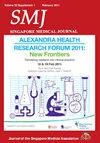评论:在新加坡接受骨盆环骨折手术后重返工作岗位
IF 1.7
4区 医学
Q2 MEDICINE, GENERAL & INTERNAL
引用次数: 0
摘要
亲爱的先生,我们饶有兴趣地阅读了Ng等人的文章《新加坡骨盆环骨折手术后重返工作岗位》。作者对影响重返工作岗位(RTW)的围手术期因素进行了值得赞扬的探讨,并强调了早期康复和重返工作岗位的重要性。然而,只分析了一个与工作有关的因素-工作久坐的二分分类。鉴于工作的异质性,我们提出了一些建议,以产生对RTW评估有意义的见解。首先,专利审查涉及对专利的功能能力进行综合评估,这些能力与专利当前工作的性质和需求有关。这只能通过详细的职业经历来实现。通常被遗忘的是,[2,3]职业史使临床医生能够确定患者在工作中实际做了什么(例如,举起重物的需要,机械的使用,工作时间,轮班工作的存在),以更好地量化再次受伤的风险,延迟恢复以及患者在多大程度上可以正常工作。第二,RTW能力是多因素的,包括心理社会和工作场所因素,如自我效能、工作场所支持、工作满意度、RTW协调方案和工作住宿的可用性这些因素没有被评估或调整,可能是潜在的混杂因素,影响检测显著相关性的能力。重返工作是一项多学科和多部门合作,雇主的参与至关重要。理想情况下,病人在完全康复前不应请病假。相反,在雇主提供适当的工作限制和住宿的情况下,通过逐步同化的方式尽早重返社会,对早期重返社会和创造更健康的劳动力至关重要编者注:作者Ng等人没有对上述信件作出回应。财政支持及赞助无。利益冲突没有利益冲突。本文章由计算机程序翻译,如有差异,请以英文原文为准。
Comments on: Return to work after surgically treated pelvic ring fractures in Singapore
Dear Sir, We read with interest the article ‘Return to work after surgically treated pelvic ring fractures in Singapore’ by Ng et al.[1] The authors have commendably explored perioperative factors affecting return to work (RTW) and underscored the importance of early rehabilitation and work reintegration. However, only one job-related factor — a dichotomous classification of job sedentariness — was analysed. Given the heterogeneity of work, we propose several suggestions to generate meaningful insights on RTW evaluations. First, RTW involves a comprehensive evaluation of patents’ functional capabilities relating to the nature and demands of their current work. This can only be achieved through a detailed occupational history. Often forgotten,[2,3] an occupational history allows the clinician to ascertain what the patient actually does at work (e.g., the need to lift loads, use of machinery, working hours, presence of shift work) to better quantify the risk of reinjury, delayed recovery and to what extent the patient can function at work. Second, the ability to RTW is multifactorial, comprising psychosocial and workplace factors like self-efficacy, workplace support, work satisfaction, RTW coordination programmes and availability of job accommodations.[4] These were not evaluated or adjusted for, and may be potential confounders affecting the ability to detect significant associations. Return to work is a multidisciplinary and multisectoral collaboration, and involvement of the employer is critical. Ideally, patients should not be on medical leave till complete recovery. Instead, early reintegration using stepwise assimilation, with appropriate job restrictions and accommodations provided by the employer are crucial in early RTW and creating a healthier workforce.[5] Editor’s note: The authors, Ng et al., did not respond to the above letter. Financial support and sponsorship Nil. Conflicts of interest There are no conflicts of interest.
求助全文
通过发布文献求助,成功后即可免费获取论文全文。
去求助
来源期刊

Singapore medical journal
MEDICINE, GENERAL & INTERNAL-
CiteScore
3.40
自引率
3.70%
发文量
149
审稿时长
3-6 weeks
期刊介绍:
The Singapore Medical Journal (SMJ) is the monthly publication of Singapore Medical Association (SMA). The Journal aims to advance medical practice and clinical research by publishing high-quality articles that add to the clinical knowledge of physicians in Singapore and worldwide.
SMJ is a general medical journal that focuses on all aspects of human health. The Journal publishes commissioned reviews, commentaries and editorials, original research, a small number of outstanding case reports, continuing medical education articles (ECG Series, Clinics in Diagnostic Imaging, Pictorial Essays, Practice Integration & Life-long Learning [PILL] Series), and short communications in the form of letters to the editor.
 求助内容:
求助内容: 应助结果提醒方式:
应助结果提醒方式:


